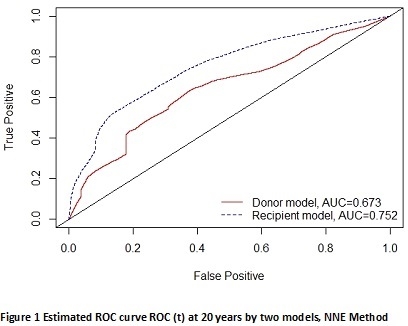Time-Effect of Donor and Recipient Characteristics on Graft Survival after Kidney Transplantation
1Surgery, Zucker School of Medicine at Hofstra/Northwell, Manhasset, NY
2Feinstein Institute, Zucker School of Medicine at Hofstra/Northwell, Manhasset, NY
3Epidemiology, Mailman Schoool of Public Health, Columbia University, New York, NY.
Meeting: 2018 American Transplant Congress
Abstract number: C58
Keywords: Allocation, Cadaveric organs, Graft survival, Resource utilization
Session Information
Session Name: Poster Session C: Kidney Donor Selection / Management Issues
Session Type: Poster Session
Date: Monday, June 4, 2018
Session Time: 6:00pm-7:00pm
 Presentation Time: 6:00pm-7:00pm
Presentation Time: 6:00pm-7:00pm
Location: Hall 4EF
Background
The current kidney allocation system (KAS) is based on the Kidney Donor Profile Index (KDPI) and the Estimated Post-Transplant Survival (EPTS), quality-based “longevity matching” strategies that provide only a momentary snapshot of expected outcomes at the time of transplantation.
The purpose of our study was to define on a continuous timeline the relative risk as well as the mutual interactions of both donor and recipient characteristics on graft survival after transplantation.
Methods
39,108 subjects who underwent kidney transplant between October 25, 1999 and January 1, 2007 were identified in the United Network for Organ Sharing (UNOS) dataset. Kidney recipients younger than 18, with missing age, and those with multiple transplants were excluded. Our primary outcome was graft survival.
Results
During the first year after transplantation, both donor and recipient models showed identical relevance. From the first to the sixth years, although the two ROC curves were nearly identical, the donor model outweighed the recipient model. Both models intersected again at the sixth year. From that time onward, the ROC curve for recipient characteristics model predominated over the ROC curve for donor characteristics model. The predictive value of the recipient model (AUC=0.752) was greater than that of the donor model (AUC=0.673) 

Conclusions
We hope that this model will provide additional guidance and risk stratification to further optimize organ allocation based on the dynamic interaction of both donor and recipient characteristics over time.
CITATION INFORMATION: Molmenti E., Yang J., Molmenti C., Grodstein E., Rilo H., Teperman L. Time-Effect of Donor and Recipient Characteristics on Graft Survival after Kidney Transplantation Am J Transplant. 2017;17 (suppl 3).
To cite this abstract in AMA style:
Molmenti E, Yang J, Molmenti C, Grodstein E, Rilo H, Teperman L. Time-Effect of Donor and Recipient Characteristics on Graft Survival after Kidney Transplantation [abstract]. https://atcmeetingabstracts.com/abstract/time-effect-of-donor-and-recipient-characteristics-on-graft-survival-after-kidney-transplantation/. Accessed December 16, 2025.« Back to 2018 American Transplant Congress
